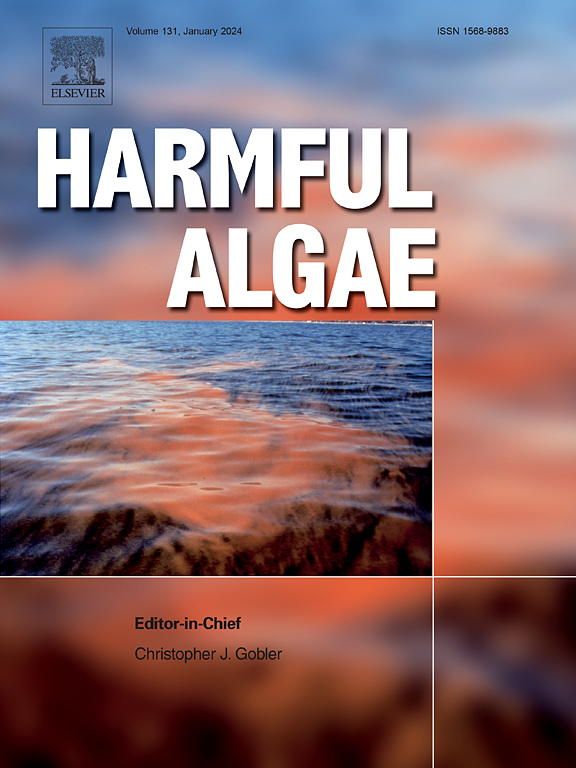暴露于产生麻痹性贝类毒素的连环亚历山大菌后,波状半月螺的毒素摄取和缓慢反射
IF 4.5
1区 生物学
Q1 MARINE & FRESHWATER BIOLOGY
引用次数: 0
摘要
相对而言,人们对海洋食草动物的麻痹性贝类毒素(PST)积累知之甚少,然而,连环亚历山大菌(Alexandrium catenella)的反复爆发已经导致野生渔场一再关闭,需要持续监测。为了确定商业收获的长春花Lunella波动是否存在PST摄取风险,进行了一项实验室实验,将草食/腐食海螺暴露于活的或衰老的catenella亚历山大微藻中。暴露21 d后,衰老藻和活藻处理动物内脏中PST浓度最高(分别为0.55±0.08和0.82±0.12 mg STX.2HCl = /kg)。两种暴露处理均未在动物足部观察到可量化的PST。内脏中的PST分布与微藻源的PST分布密切匹配,表明波状螺旋藻通过直接掠食营养型螺旋藻细胞摄取PST。在整个暴露期间,放牧活动在所有处理中保持不变。然而,与对照组相比,暴露于catenella的长春花在接触时缩回脚的速度明显慢于对照组(第7天和第11天分别在死藻和活藻处理中首次观察到)。随着时间的推移,这种影响变得更加明显,并且与更高的PST浓度相吻合。虽然暴露于活微藻和对照组的动物的翻正速度没有差异,但暴露于衰老藻类的动物的翻正速度通常较慢(从第4天开始观察)。这些发现对长春螺和相关海洋食草动物生物毒素管理的意义进行了讨论。本文章由计算机程序翻译,如有差异,请以英文原文为准。

Toxin uptake and slowed reflexes by the marine snail Lunella undulata following exposure to paralytic shellfish toxin producing Alexandrium catenella
Comparatively little is known about paralytic shellfish toxin (PST) accumulation by marine grazers, yet recurrent blooms of Alexandrium catenella have caused repeated closures of wild fisheries and require ongoing monitoring. To determine if the commercially harvested periwinkle Lunella undulata is at risk of PST uptake, a laboratory experiment was conducted exposing the herbivorous/detritovorous marine snails to either live or senescent Alexandrium catenella microalgae. After 21 days of exposure, the highest PST concentrations were observed in the viscera of animals in the senescent and live algal treatments (0.55±0.08 and 0.82±0.12 mg STX.2HCl eq./kg, respectively). No quantifiable PST was observed in the foot of animals from either exposure treatment. The PST profile in the viscera closely matched that of the microalgal source, suggesting PST uptake through direct grazing of L. undulata on vegetative A. catenella cells. Grazing activity remained unchanged throughout the exposure period across all treatments. However, periwinkles exposed to A. catenella were significantly slower to retract their foot in response to touch than those animals in the control treatment (first observed on days 7 and 11 in the dead and live algae treatments, respectively). This effect became more pronounced over time and coincided with higher PST concentrations. While righting speed did not differ between animals exposed to live microalgae and the control, those exposed to senescent algae were generally slower to right (observed from day 4 onwards). The implications of these findings for biotoxin management in periwinkles and related marine grazers are discussed.
求助全文
通过发布文献求助,成功后即可免费获取论文全文。
去求助
来源期刊

Harmful Algae
生物-海洋与淡水生物学
CiteScore
12.50
自引率
15.20%
发文量
122
审稿时长
7.5 months
期刊介绍:
This journal provides a forum to promote knowledge of harmful microalgae and macroalgae, including cyanobacteria, as well as monitoring, management and control of these organisms.
 求助内容:
求助内容: 应助结果提醒方式:
应助结果提醒方式:


